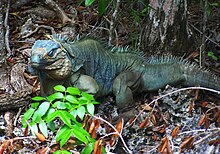Blue iguana
The blue iguana (Cyclura lewisi), also known as the Grand Cayman iguana, or Cayman Island blue iguana, is an endangered species of lizard endemic to the island of Grand Cayman.[4]
| Blue iguana | |
|---|---|

| |
| A male in the Queen Elizabeth II Botanic Park, Grand Cayman | |
| Scientific classification | |
| Domain: | Eukaryota |
| Kingdom: | Animalia |
| Phylum: | Chordata |
| Class: | Reptilia |
| Order: | Squamata |
| Suborder: | Iguania |
| Family: | Iguanidae |
| Genus: | Cyclura |
| Species: | C. lewisi
|
| Binomial name | |
| Cyclura lewisi (C. Grant, 1940)
| |
| Synonyms | |

The blue iguana is the largest native land animal on Grand Cayman. It has a length from nose-to-tail of 5 ft (1.5 m). It is tan to gray in color with a bluish cast (more so in males and during breeding season). It is large and heavy-bodied with a dorsal crest of short spines running from the bottom of the neck to the end of the tail. It weighs as much as 30 lb (14 kg). The blue iguana is one of the longest-living lizards: the record is 67 years.
The iguana prefers rocky, sunlit, open areas in dry forests or near the shore. The blue iguana's herbivorous diet is plants, fruits and flowers. Fossil records suggest there were many blue iguanas before European settlement; but less than 15 of them were left in the wild in 2003, which were predicted to disappear within a few years. Their decline is due to predators like feral pets (cats and dogs) and also the destruction of their natural habitat. Fruit farms have been turned into pasture for cattle grazing.
Since 2004, hundreds of bred and collected blue iguanas have been led into a reserve on Grand Cayman. In this way it is hoped to save the species.[5] At least five non-profit organizations are working with the government of the Cayman Islands to ensure this. The conservancy program has released over 700 captive bred Grand Cayman blue iguanas since the 2004 all-time low of 12 remaining animals.[6]
References
change- ↑ Burton, F.J. (2012). "Cyclura lewisi". IUCN Red List of Threatened Species. 2012. Retrieved June 10, 2012.
- ↑ Schwartz, Albert; Thomas, Richard (1975). Carnegie Museum of Natural History Special Publication No. 1 — A Check-list of West Indian Amphibians and Reptiles. Special publication. Vol. 1. Pittsburgh, Pennsylvania: Carnegie Museum of Natural History. p. 113. doi:10.5962/bhl.title.123681.
- ↑ Species Cyclura lewisi at The Reptile Database . www.reptile-database.org.
- ↑ It was previously listed as a subspecies of the Cuban iguana, but is now a distinct species, based on genetic analysis.
- ↑ Knapp, Charles R. & Hudson, Richard 2004. Translocation strategies as a conservation tool for West Indian iguanas. In Iguanas: biology and conservation. University of California Press, 199–209. ISBN 978-0-520-23854-1
- ↑ According to the November 9, 2013 episode of Ocean Mysteries with Jeff Corwin.
Other websites
change- Blue Iguana Recovery Program (B.I.R.P.) Archived 2010-04-03 at the Wayback Machine
